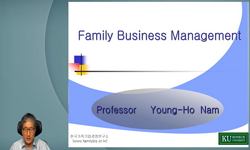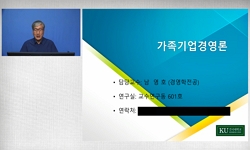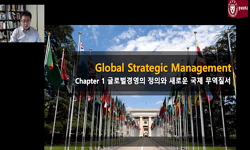This study examines the association between Co-CEOs structure and firm value. Especially, We examine the differences by Co-CEOs into family and non-family group. In addition, we examine whether Co-CEOs structure has a moderating effect on the relation...
http://chineseinput.net/에서 pinyin(병음)방식으로 중국어를 변환할 수 있습니다.
변환된 중국어를 복사하여 사용하시면 됩니다.
- 中文 을 입력하시려면 zhongwen을 입력하시고 space를누르시면됩니다.
- 北京 을 입력하시려면 beijing을 입력하시고 space를 누르시면 됩니다.


가족 및 비가족 공동경영자 구조와 기업가치 : 경영전략에 따른 공동경영자 구조의 역할 검토 = Firm Value of Family Co-CEOs versus Non-Family Co-CEOs : The Role of Co-CEOs by Business Strategy
한글로보기https://www.riss.kr/link?id=A106268760
- 저자
- 발행기관
- 학술지명
- 권호사항
-
발행연도
2019
-
작성언어
-
-
주제어
가족 기업 ; 비가족 기업 ; 공동경영자 ; 경영전략 ; 기업가치 ; Family firm ; Non-family firm ; Co-CEOs ; Business strategy ; Firm value
-
KDC
300
-
등재정보
KCI우수등재,SCOPUS
-
자료형태
학술저널
- 발행기관 URL
-
수록면
113-144(32쪽)
-
KCI 피인용횟수
0
- DOI식별코드
- 제공처
- 소장기관
-
0
상세조회 -
0
다운로드
부가정보
다국어 초록 (Multilingual Abstract)
This study examines the association between Co-CEOs structure and firm value. Especially, We examine the differences by Co-CEOs into family and non-family group. In addition, we examine whether Co-CEOs structure has a moderating effect on the relationship between business strategy(Prospector, Defender) and firm value. We find that Co-CEOs structure does not have a significant association with firm value. Furthermore, Co-CEOs structure of family group have a negative effect on firm value while Co-CEOs structure of non-family group have a positive effect on firm value. This implies that Co-CEOs structure of family group can be utilized by executives’ pursuit of private interests such as the purpose of management succession. On the other hand, Co-CEOs structure of non-family group is highly likely to be the strategic purpose of management, there can be positive effects such as mutual monitoring among Co-CEOs or creation of synergy. In addition, We find that the negatively moderating effect of Co-CEOs structure is in the association between business strategy and firm value, which is particularly prominent in family group. This study presents the results of empirical analysis on the relationship between Co-CEOs structure(family and non-family group) and firm value. Based on these results, we show the functional effects of the Co-CEOs structure. Furthermore, it is expected that Co-CEOs structure can enhance firm value and provide useful information for business practice.
참고문헌 (Reference)
1 김유진, "최고경영자의 경영권 집중도와 신용등급에 관한 연구" 한국회계학회 27 (27): 95-120, 2018
2 곽영민, "최고경영자에 대한 경영권 집중화 수준과 기업가치" 한국회계학회 42 (42): 187-226, 2017
3 지성권, "산업경쟁요인에 따른 경쟁전략과 기업성과간의 관련성 연구" 한국회계학회 38 (38): 1-41, 2013
4 강형철, "기업집단에서 지배주주 가족에 의한 경영과 기업성과" 한국재무학회 27 (27): 141-176, 2014
5 원자연, "기업수명주기와 경쟁전략이 성과의 지속성에 미치는 영향" 한국회계학회 25 (25): 33-65, 2016
6 박진하, "공동경영자 구조와 투자효율성" 대한경영학회 31 (31): 557-575, 2018
7 이지연, "공동경영자 구조와 상호견제효과: 이익조정을 중심으로" 한국창업학회 13 (13): 55-84, 2018
8 김유진, "경영전략이 기업의 사회적 책임 활동과 기업성과 간의 관계에 미치는 영향" 한국회계학회 27 (27): 127-161, 2018
9 김유진, "경영전략과 경영자 보상체계의 적합성이 기업성과에 미치는 영향에 관한 연구" 한국회계학회 26 (26): 45-72, 2017
10 O’Toole, J., "When two (or more) heads are better than one: The promise and pitfalls of shared leadership" 44 (44): 65-83, 2002
1 김유진, "최고경영자의 경영권 집중도와 신용등급에 관한 연구" 한국회계학회 27 (27): 95-120, 2018
2 곽영민, "최고경영자에 대한 경영권 집중화 수준과 기업가치" 한국회계학회 42 (42): 187-226, 2017
3 지성권, "산업경쟁요인에 따른 경쟁전략과 기업성과간의 관련성 연구" 한국회계학회 38 (38): 1-41, 2013
4 강형철, "기업집단에서 지배주주 가족에 의한 경영과 기업성과" 한국재무학회 27 (27): 141-176, 2014
5 원자연, "기업수명주기와 경쟁전략이 성과의 지속성에 미치는 영향" 한국회계학회 25 (25): 33-65, 2016
6 박진하, "공동경영자 구조와 투자효율성" 대한경영학회 31 (31): 557-575, 2018
7 이지연, "공동경영자 구조와 상호견제효과: 이익조정을 중심으로" 한국창업학회 13 (13): 55-84, 2018
8 김유진, "경영전략이 기업의 사회적 책임 활동과 기업성과 간의 관계에 미치는 영향" 한국회계학회 27 (27): 127-161, 2018
9 김유진, "경영전략과 경영자 보상체계의 적합성이 기업성과에 미치는 영향에 관한 연구" 한국회계학회 26 (26): 45-72, 2017
10 O’Toole, J., "When two (or more) heads are better than one: The promise and pitfalls of shared leadership" 44 (44): 65-83, 2002
11 Schulze, W. S., "Toward a theory of agency and altruism in family firms" 18-, 2003
12 Lang, L. H. P., "Tobin's q, corporate diversification, and firm performance" 102 (102): 1248-1280, 1994
13 Jensen, M. C., "Theory of firm: Managerial behavior, agency costs, and capital structure" 3 : 305-360, 1976
14 Ittner, C. D., "The use of performance measures in annual bonus contracts" 72 (72): 231-255, 1997
15 Jermias, J, "The relative influence of competitive intensity and business strategy on the relationship between financial leverage and performance" 40 (40): 71-86, 2008
16 Waddock, S. A., "The corporate social performance-financial performance link" 18 (18): 303-319, 1997
17 Bebchuk, L., "The CEO pay slice" 102 : 199-221, 2011
18 Cannella, A. A., "Succession as a sociopolitical process: Internal impediments to outsider selection" 36 (36): 763-793, 1993
19 Fama, E. F., "Separation of ownership and control" 26 (26): 301-325, 1983
20 Dess, G. F., "Porter’s (1980) generic strategies as determinants of strategic group membership and organizational performance" 27 (27): 467-488, 1984
21 Kandel, E., "Peer pressure and partnerships" 100 : 801-817, 1992
22 Miles, R. E., "Organizational strategy, structure, and process" Stanford University Press 2003
23 Miles, R. E., "Organizational strategy, structure, and process" McGraw-Hill 1978
24 Tobin, J., "Money, credit and capital" Irwin/McGraw-Hill 1998
25 Bertrand, M., "Mixing family with business: A study of Thai business groups and the families behind them" 88 (88): 466-498, 2008
26 Bertrand, A. Schoar, "Managing with style: The effect of managers on firm policies" 118 : 1169-1208, 2003
27 Cox, J. D, "Managing and monitoring conflicts of interest: Empowering the outside directors with independent counsel" 48 : 1077-1095, 2003
28 Horngren, C. T., "Management and cost accounting" Prentice Hall 2002
29 Arena, M. P., "It Takes Two, The Incidence and Effectiveness of Co-CEOs" 46 (46): 385-412, 2011
30 Morck, R. K., "Inherited wealth, corporate control and economic growth: The Canadian disease" National Bureau of Economic Research 1998
31 Villalonga, B., "How do family ownership, control and management affect firm value?" 80 (80): 385-417, 2006
32 Fahlenbrach, R, "Founder-CEOs, investment decisions, and stock market performance" 44 (44): 439-466, 2009
33 March, J. G., "Exploration and exploitation in organizational learning" 2 (2): 71-87, 1991
34 Dennis, S. A., "Dual or Duel: Co-CEOs and firm performance" 15 (15): 1-25, 2009
35 Black, B. S., "Does corporate governance affect firm’s market value? Evidence from Korea" 22 (22): 366-413, 2006
36 Banker, R. D., "Does a differentiation strategy lead to more sustainable financial performance than a cost leadership strategy?" 52 (52): 872-896, 2014
37 Easton, P. D., "Cross-Sectional variation in the stock market response to accounting earnings announcements" 11 (11): 117-141, 1989
38 Porter, M. E., "Competitive strategy techniques for analyzing industries and competitors" New York 300-, 1980
39 Tsui, J. S., "CEO Domination, Growth Opportunities, and Their Impact on Audit Fees" 16 : 189-208, 2001
40 Bentley, K. A., "Business strategy, financial reporting irregularities, and audit effort" 30 (30): 780-817, 2013
41 Rhee, M., "Aligning operations, marketing, and competitive strategies to enhance performance: An empirical test in the retail banking industry" 34 (34): 505-515, 2006
42 McConnell, J., "Additional evidence on equity ownership and corporate value" 27 (27): 595-612, 1990
43 Fahy, J, "A resource-based analysis of sustainable competitive advantage in a global environment" 11 : 57-78, 2002
동일학술지(권/호) 다른 논문
-
영업자산 집중도가 경영자의 이익조정방법 선택에 미치는 영향
- 한국회계학회
- 기도훈 ( Do Hoon Ki )
- 2019
- KCI우수등재,SCOPUS
-
접대비 지출 관련 제도 변화가 기업의 접대비 수익 관련성에 미치는 영향
- 한국회계학회
- 최병철 ( Byungchul Choi )
- 2019
- KCI우수등재,SCOPUS
-
공익법인의 회계정보가 기부자의 기부의사결정에 미치는 영향 : 예산집행 정보와 회계품질을 중심으로
- 한국회계학회
- 한승엽 ( Seung-youb Han )
- 2019
- KCI우수등재,SCOPUS
-
- 한국회계학회
- 이미영 ( Mi-young Lee )
- 2019
- KCI우수등재,SCOPUS
분석정보
인용정보 인용지수 설명보기
학술지 이력
| 연월일 | 이력구분 | 이력상세 | 등재구분 |
|---|---|---|---|
| 2020 | 평가예정 | 계속평가 신청대상 (등재유지) | |
| 2015-01-01 | 평가 | 우수등재학술지 선정 (계속평가) | |
| 2011-01-01 | 평가 | 등재학술지 유지 (등재유지) |  |
| 2009-01-01 | 평가 | 등재학술지 유지 (등재유지) |  |
| 2007-01-01 | 평가 | 등재학술지 유지 (등재유지) |  |
| 2005-01-01 | 평가 | 등재학술지 유지 (등재유지) |  |
| 2002-01-01 | 평가 | 등재학술지 선정 (등재후보2차) |  |
| 1999-07-01 | 평가 | 등재후보학술지 선정 (신규평가) |  |
학술지 인용정보
| 기준연도 | WOS-KCI 통합IF(2년) | KCIF(2년) | KCIF(3년) |
|---|---|---|---|
| 2016 | 1.96 | 1.96 | 2.48 |
| KCIF(4년) | KCIF(5년) | 중심성지수(3년) | 즉시성지수 |
| 2.65 | 2.74 | 5.829 | 0.22 |





 KISS
KISS







